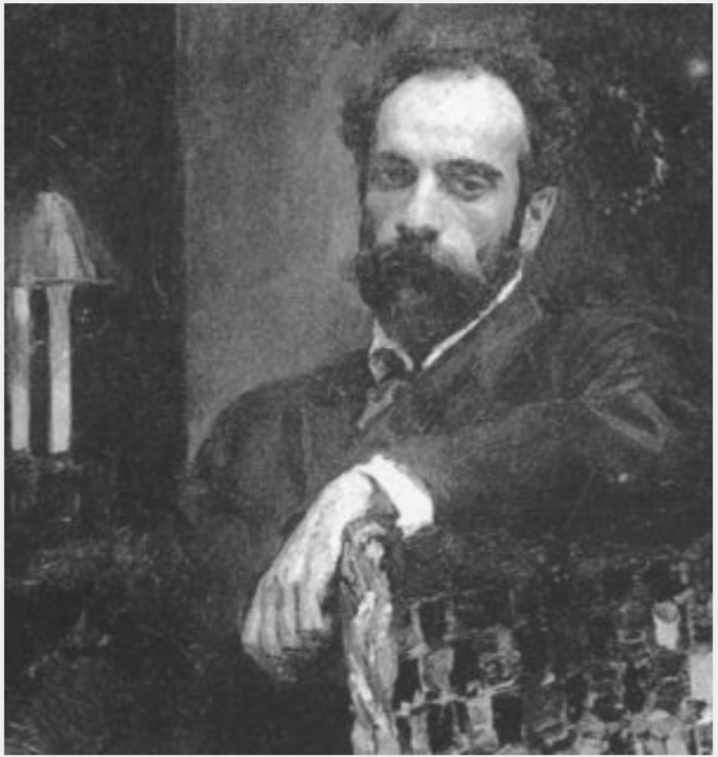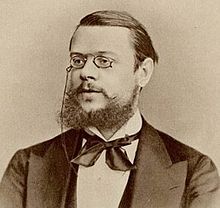
Publicity Portrait of Lea Luboshutz
Lea, in one of her first official publicity portraits. The violin she is holding is a magnificent example of the work of Nicolo Amati, the eminent luthier from Cremona, Italy. It was a gift from the wealthy Russian banker, Lazar Polyakov, who had been Lea’s patron while she was a student at the Moscow Conservatory.

Cèsar Franck
The Belgian composer who presented his great sonata for violin and piano to his countryman, the violinist Eugène Ysaÿe in 1886. Subsequently, Ysaye taught the piece to Lea Luboshutz. © Lebrecht Music Arts / Bridgeman Images

Portrait of Onissim Goldovsky
Onissim Goldovsky was Lea’s patron and later the father of her children. Some have claimed that this portrait was painted by Leonid Pasternak who assisted Onissim in putting together a publication in 1901 to raise money for indigent Jews. Pasternak’s wife, Rosa, a pianist, performed for a brief time with Lea and her sister Anna, including at Tolstoy’s memorial service in Moscow. The Pasternak’s son Boris became world famous as the author of Doctor Zhivago.

Polina Suslova
Polina Suslova, the mistress of Dostoyevsky and later the wife of Onissim’s friend, the philosopher Vasily Rozanov. During a summer visit to the pair in Bryansk, Onissim rejected Polina’s advances and paid dearly for it. In her anger, she denounced him to the police.

Prince Alexander Ivanovich Urusov
Prince Alexander Ivanovich Urusov was one of the great legal minds in Russia in the 19th century. Onissim benefited greatly from his tutelage and patronage. It was Urusov who introduced Onissim to the younger man’s future wife, Rashel Khin.

Rashel Khin
Rashel Mironovna Khin, Onissim Goldovsky’s wife, was considered one of the great intellectuals of her day. A writer and translator of major French works, she also hosted a salon in Moscow and at her country estate. For years, she rejected the warnings of friends that her husband was unfaithful to her.

The Wolf Family
The Wolf clan, German Jews who settled in Philadelphia, became leaders of the business community there. It was Walter (Billy) Wolf who married Lea and Onissim’s daughter, Irina (later Irene). Billy’s father, Albert is the child pictured all the way to the left.

Anna Luboshutz
Anna Luboshutz, Lea’s younger sister, was also a prodigy and like Lea won the gold medal at the Moscow Conservatory. Unlike the rest of the family, she stayed in the Soviet Union after the 1917 Revolution with her husband, the physician Nikolai Shereshevsky. Despite his eminence, he was arrested on trumped up charges as part of Stalin’s infamous “Doctors’ Plot” in 1953.

Pierre Luboshutz (left)
Pierre (left), the youngest of the three Luboshutz siblings, was a pianist. Like his sisters, he also graduated from the Moscow Conservatory and began performing as an accompanist for many of the leading instrumentalists and singers of the day. The unidentified gentleman on the right may be one of these performers. Does anyone know who he is? Please let the author know.

Isadora Duncan
Isadora Duncan, the American dancer who established a whole new technique of free-flowing movement, became quite popular in Russia. Her style of dance and her flamboyant reputation made it difficult to find an accomplished pianist who would work with her. Young Pierre Luboshutz had no qualms and worked with her for several years. It was Duncan who helped Pierre leave the Soviet Union after the Revolution of 1917.

The Luboshutz Trio
It was perhaps inevitable that the three Luboshutz siblings would form a trio to capitalize on Lea’s growing fame. The group was in great demand throughout Russia. During a single tour in 1913-1914, the group played in fifty cities during a five-month period, a remarkable accomplishment given the fact that performances took place during the harsh winter months when travel was challenging.

Lea, 1925 Publicity Photograph
During her 1925 tour of the United States, Lea made an effort to meet wealthy music lovers who could become her patrons. Among them was Mrs. Lessing Rosenwald, whose husband was heir to the Sears fortune. In examining the inscription on this photo, one can see that Lea had still not settled on the final Anglicized spelling of her name and includes a “c” in “Luboschutz,” which by the next year was eliminated.

Yuri Goldovsky
Yuri Goldovsky, oldest son of Lea Luboshutz and Onissim Goldovsky, showed great promise as a mathematician, matriculating at Moscow University at the age of sixteen. Coddled by the Soviets and treated well by his Aunt Anna’s family, he had no intention of leaving the Soviet Union despite Lea’s pleas.

Boris Goldovsky
Boris Goldovsky, Yuri’s younger brother and Lea and Onissim’s second son, became a professional musician out of necessity at the age of nine, accompanying his mother, to help support the family after the Russian Revolution. His earliest concert attire was a sailor suit as pictured here. He continued to appear in high-profile concerts with Lea in Western Europe and the United States. Eventually he became a conductor and opera producer.

Irina (later known as Irene) Goldovsky
Irina (later known as Irene) Goldovsky, Lea’s third and youngest child, was born nine years after her brother Boris, just at the time the Russian Revolution was breaking out in 1917. At one time, Lea had hopes that Irina might have a career as a dancer. Eventually that idea was abandoned in favor of bringing Irene up as a proper lady who would dress elegantly, have perfect manners, and marry a rich man.

Mary Louise Curtis Bok
Mary Louise Curtis Bok, the daughter of the founder of the Curtis Publishing Company, put her immense fortune to work in founding the Curtis Institute of Music in Philadelphia. Lea joined the Curtis faculty in 1927 and the two women enjoyed a close friendship until Lea’s death nearly forty years later.

Lea’s Stradivarius
The “Rossignol,” or the Nightingale Stradivarius violin, was a gift to Lea from the Naumberg family. Note the magnificent back of the violin from a single piece of maple cut on the slab. This was Lea’s concert instrument from the late 1920s until her retirement and eventually went to one of her students, Rafael Druian, upon her death in 1965.

Harbor at Rockport, Maine
In 1929, Mrs. Bok decided to establish a Curtis summer music colony in Rockport, Maine. Faculty members of the Institute, including Lea, were encouraged to bring students who would benefit from year-round instruction. The transformation of Rockport’s commercial waterfront required year-round employment of scores of local men who had lost their jobs with the advent of the world-wide Depression. Rockport and its neighboring town, Camden, were thus spared the worst effects of the economic downturn.

Rockport Village
This view of Rockport Village from the outer Harbor is enhanced by the Camden Hills in the background. Today, the harbor is a favorite destination of yachtsmen who can enjoy gourmet restaurants only a short walk from the shore. Concerts continue to be a feature of the town on Thursday and Friday nights during the summer months.


















